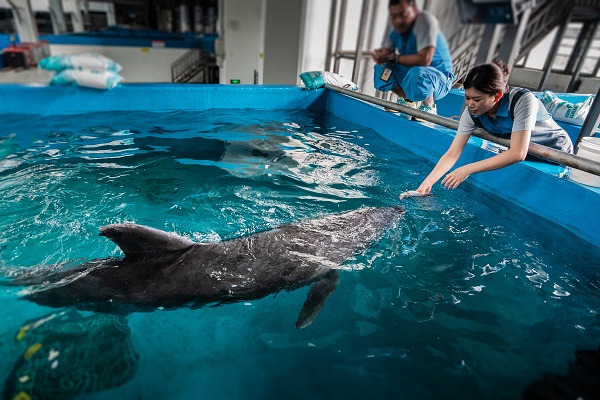Rescued dolphin returned to the sea


Staff at the Danzhou Haihua Island Marine Biology Research Base takes care of the dolphin. [Photo provided to ehainan.gov.cn]
The first Indo-Pacific bottlenose dolphin rescued and successfully treated in Hainan province was released back into the sea on Wednesday morning. After entering the water, he quickly swam away.
Before the release, professionals from Danzhou Haihua Island Marine Biology Research Base investigated dolphin habitats, nearby coral reefs, shipping routes and fixed fishing nets, and finally decided on a safe release location.
Indo-Pacific bottlenose dolphins have previously been found in the western waters of Hainan, and this release site will help the dolphin return home, marine experts said.
The gray, male adult Indo-Pacific bottlenose dolphin, about 2.6 meters long and weighing more than 180 kilograms, had lost his way, been injured and was found stranded on the shore near Qizi Bay in Changjiang Li autonomous county on April 7. The dolphin was transferred to the marine biology research base in Danzhou for treatment on his wounds.
Zhang Yudong, animal director at Danzhou Haihua Island Marine Biology Research Base, recalled that when he first saw the dolphin, it was disoriented and in shock. "The severe abdominal wound was as large as the size of a fist. Even worse, it was infected and his body temperature was below normal," Zhang said.
To rescue the dolphin, staff at the research base tested his blood, carried out physical examinations and applied medicines to his wounds.
Thanks to the round-the-clock professional care, the dolphin, who the staff named Chess after the Qizi Bay — meaning chess piece — it was found near, was out of danger within a month. After more than two months, the dolphin's health improved significantly.
The staff also paid attention to Chess' mental health. After he had gradually recovered, they put a swimming ring on him to help him float. When he got used to his own movements again, they moved him to a pool so that he could slowly get back to swimming freely.
"We followed Chess the whole way through. He was always close to the edge of the pool for us to pet him," Zhang said. "Through all kinds of care and company, Chess gradually regained his vitality."
After 10 months of intensive care at the base, Chess fully recovered and in February underwent sea survival skills training, such as hunting, ocean scene simulation and identification of the same species so that he could readapt to nature after release.
To help him regain his hunting ability, the staff put live herring in the pool for him to hunt and eat.
"Due to the length of treatment, care and companionship, an emotional bond developed between staff and Chess," said Zhang. "But as soon as the preparation for his return to the wild began, we started to reduce our staff's contact with him, so that he could gradually regain his vigilance for human beings and increase his social time with other dolphins at the base."
The successful rescue and treatment of the Indo-Pacific bottlenose dolphin is considered evidence of Hainan's aquatic wildlife rescue system's development. So far, 16 aquatic wildlife rescue organizations have been established in the province. Apart from research institutes and bases, aquariums also provide important support for the rescue system.
The government plans to cooperate with public welfare organizations, enhance science popularization in fishing wharves and villages, coastal tourist attractions and schools, and increase investment in rescue equipment and facilities to meet the needs of aquatic wildlife rescue, according to the provincial department of agriculture and rural affairs.
MOST POPULAR
- 1 $39.7 billion worth of deals inked at Airshow China
- 2 China announces tax relief measures to stabilize real estate sector
- 3 A look at China's economy in October, 2024
- 4 Public holiday extension announced
- 5 China's NEV annual production hits 10 million milestone amid global carbon reduction efforts
Editors' Picks
 Infographic:
A look at China's economy in October, 2024
Infographic:
A look at China's economy in October, 2024
 Infographic:
G20 at a glance
Infographic:
G20 at a glance
 Video:
Peru sees new port open
Video:
Peru sees new port open
 Infographic:
China's public holidays for 2025
Infographic:
China's public holidays for 2025
 Infographic:
Basic facts of APEC
Infographic:
Basic facts of APEC


